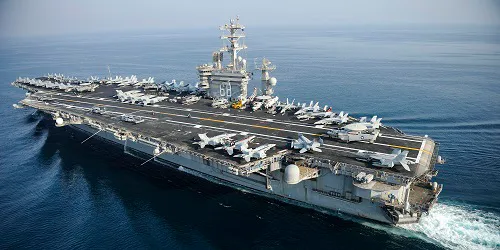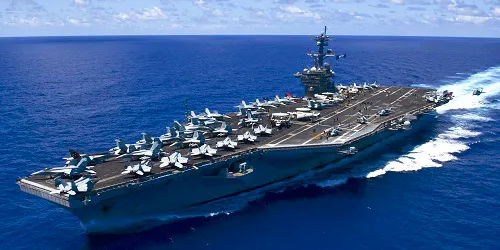On June 16, 2025, the U.S. Navy’s USS Nimitz (CVN-68) Carrier Strike Group (CSG) was abruptly rerouted from the South China Sea to the Middle East, marking a significant shift in U.S. naval strategy as tensions between Israel and Iran intensify. This redeployment, observed by Cruising Earth’s ship tracking data more than 14 hours before official press releases, underscores the U.S. military’s rapid response to a volatile geopolitical crisis. The move positions the Nimitz alongside the USS Carl Vinson, creating a rare dual-carrier presence in the region, a clear signal of U.S. resolve amid escalating missile exchanges and regional instability.
The USS Nimitz, a nuclear-powered supercarrier commissioned in 1975, is the oldest active aircraft carrier in the U.S. Navy and the lead ship of its class. Accompanied by Carrier Air Wing 17 and four Arleigh Burke-class destroyers—USS Curtis Wilbur, USS Gridley, USS Wayne E. Meyer, and USS Lenah Sutcliffe Higbee—the Nimitz CSG is a formidable force capable of projecting power, ensuring maritime security, and delivering precision strikes. Its air wing, equipped with F/A-18 Super Hornets, E/A-18G Growlers, E-2D Hawkeyes, and MH-60R/S Sea Hawks, provides unmatched versatility for both offensive and defensive operations. The group’s redeployment from the Indo-Pacific, where it was conducting maritime security operations, highlights the Pentagon’s prioritization of the Middle East as the Israel-Iran conflict enters its fourth day of open hostilities.
Cruising Earth’s live military ship tracker first detected the Nimitz’s westward trajectory through the Strait of Malacca on June 15, 2025, at approximately 3:30 AM CDT, over 14 hours before Reuters and other outlets reported the cancellation of a planned port call in Danang, Vietnam, citing an “emergent operational requirement.” This early detection, sourced from global AIS tracking data, illustrates the value of real-time maritime monitoring in anticipating major military movements. The Nimitz’s shift from the South China Sea, where it was demonstrating U.S. commitment to a free and open Indo-Pacific, to the Middle East reflects the urgency of the ongoing crisis.
The Israel-Iran conflict, marked by Israeli strikes on Iranian nuclear facilities and Iran’s retaliatory missile barrages, has raised fears of a broader regional war. The U.S. has bolstered its military presence, with the Nimitz joining the USS Carl Vinson, which has been operating in the Arabian Sea since November 2024. This dual-carrier deployment, a rare occurrence last seen in the region in 2024, enhances U.S. defensive and offensive capabilities. The Nimitz’s air wing can intercept drones and missiles, while its destroyers, equipped with Aegis combat systems, provide ballistic missile defense, as evidenced by recent U.S. assistance in intercepting Iranian projectiles targeting Israel.
The Pentagon’s decision, reportedly influenced by President Donald Trump’s National Security Council, also involves deploying over 30 KC-135 and KC-46 aerial-refueling tankers to Europe, supporting potential long-range air operations. This buildup, however, pulls critical assets from the Indo-Pacific, raising concerns about balancing commitments in a region where China’s naval presence remains a challenge. The Nimitz, on what may be its final deployment before decommissioning in 2026, underscores the U.S. Navy’s enduring reliance on its carrier strike groups for rapid crisis response.
The redeployment signals U.S. support for Israel’s defense while deterring further Iranian aggression. As the Nimitz approaches the Middle East, its presence reinforces America’s commitment to regional allies and freedom of navigation. Cruising Earth’s early detection of this movement highlights the importance of open-source intelligence in understanding global military dynamics, offering a glimpse into the strategic chessboard of international relations.

USS Nimitz (CVN-68) Live Military Ship Tracker | Free Real-Time Tracking of USS Nimitz
Track USS Nimitz (CVN-68) current location for FREE in real-time with our live military ship tracker. View USS Nimitz's latest position, route, speed, course history, itinerary updates, port destinations, estimated arrival times, and more about this United States Navy ship.

USS Carl Vinson (CVN-70) Live Military Ship Tracker | Free Real-Time Tracking of USS Carl Vinson
Track USS Carl Vinson (CVN-70) current location for FREE in real-time with our live military ship tracker. View USS Carl Vinson's latest position, route, speed, course history, itinerary updates, port destinations, estimated arrival times, and more about this United States Navy ship.
Sources: Cruising Earth, Reuters, USNI News, Newsweek
